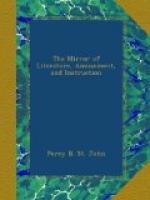Edward IV.—The groats common, except those of Norwich and Coventry, spelled “Norwic” and “Covetre.” The half-groat and halfpenny scarce, the penny and farthing rare. The Bristol penny is extremely rare.
Richard III.—All this king’s coins are very rare, except the groat, which is less rare than the others, some groats having lately been discovered. The Canterbury-penny of Richard III. CIVITAS CANTOR, supposed unique, sold at a public sale a short time since, for seven pounds ten shillings. The Durham penny of the same king brought four guineas.
Henry VII.—Folkes, in his Table of English Silver Coins, after describing the various pieces coined by Henry VII., says, “We may further in this place take notice of a very uncommon and singular coin, charged with the royal arms, but without a name. The arms are surmounted with an arched crown, and placed between a fleur-de-lis and a rose, legend DOMINE-SALVVM. FAC. REGEM; on the other side is fleur-de-lis and a lion of England, and an arched crown between them above, and a rose below, with this inscription, MANA. TECKEL. PHARES. 1494. An English lion also for a mint mark. It is, by the make and size, a French gross, and is supposed to have been coined by the Duchess of Burgundy, for Perkin Warbeck, when he set out to invade England.” There are also half-groats of this coinage, with the same date, one of which brought twenty guineas at a sale in London in 1827.
Milled Money.—The artist first employed on the milled money of England was a Frenchman, named Philip Mestrelle, who was executed at Tyburn, on the 27th of January, 1569, having been found guilty of making counterfeit money.
Charles I.—The obsidional, or siege pieces, struck by the partizans of this monarch during the civil wars, are extremely interesting, and, with the exception of those coined at Newark, are all rare. They may be known by their shape from every other English coin, as well as by their legends. Those of Newark are of a diamond or lozenge form, some are octangular, and others of a shape that would puzzle a geometrician. Some have the rude representation of a castle; others, a crown; and many have the initials, C.R., and the legend DVM. SPIRO. SPERO.
Oliver Cromwell.—The coins of Oliver were the production of the inimitable Simon, whose works are to this day admired and prized. Some have doubted whether they ever were in circulation, but it is now pretty generally allowed that they were.
Charles II.—The milled money of this king is of a very different style, and has the head laureated. All the pieces of this coinage are common. To the eternal disgrace of Charles, he encouraged an artist whom he had brought over from Antwerp, and gave the preference to his works before those of Simon, who produced in the year 1663, a pattern crown of most extraordinary workmanship, on the edge of which was the following petition in two lines:




